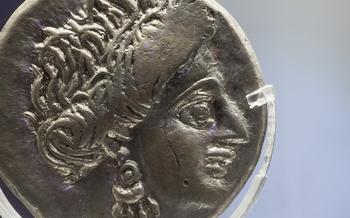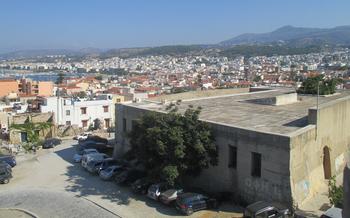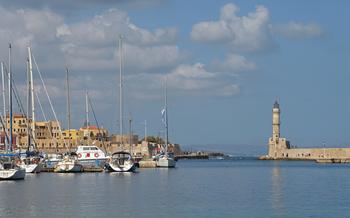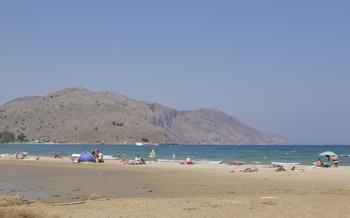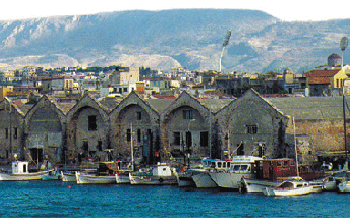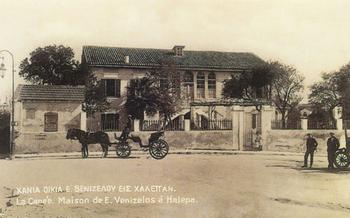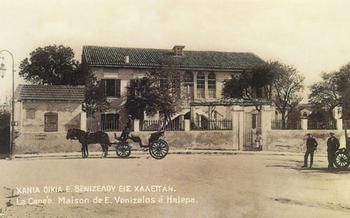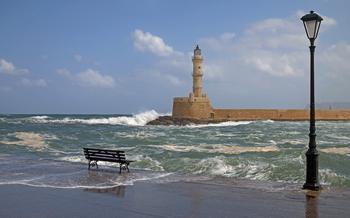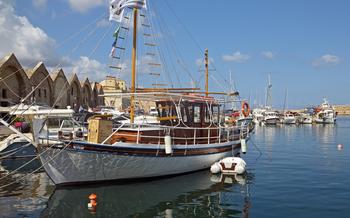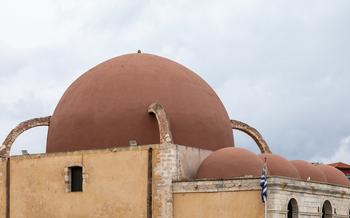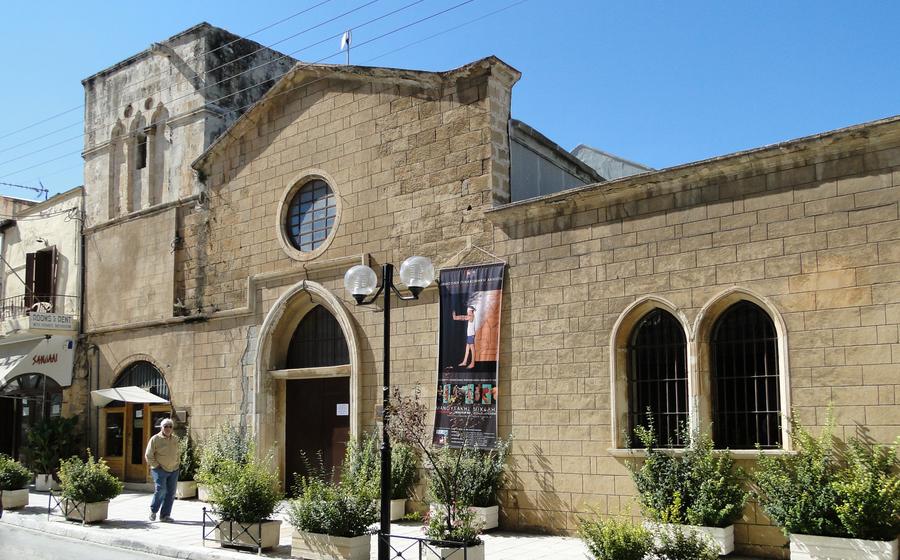
Chania Archaeological Museum
- Historical Background: A Journey Through Time
- Location and Accessibility
- Museum Hours and Admission Fees
- Exhibitions and Collections
- Minoan and Roman Collections
- Byzantine and Post-Byzantine Collections
- Venetian and Ottoman Collections
- Temporary Exhibitions
- Guided Tours
- Museum Shop
- Accessibility and Facilities
- Photography and Videography
- Educational Programs
- Events and Activities
- Insider Tip:
Historical Background: A Journey Through Time
Chania, a vibrant city on the island of Crete, boasts a rich and diverse history that spans several civilizations. The Chania Archaeological Museum stands as a testament to this rich tapestry of cultures, housing a vast collection of artifacts that tell the story of Crete's past.
The museum's exhibits take visitors on a journey through time, from the Minoan civilization, which flourished on Crete during the Bronze Age, to the Roman, Venetian, and Ottoman periods. The Minoans, known for their advanced culture and maritime prowess, left behind a legacy of exquisite pottery, intricate jewelry, and sophisticated tools.
The Roman Empire's influence on Crete can be seen in the impressive Roman sculptures and architectural fragments on display. During the Venetian era, Chania served as a strategic outpost for the Venetian Republic, and the museum showcases Venetian paintings, coins, and other artifacts that reflect the city's cosmopolitan character.
The Ottoman period, which lasted for over four centuries, left its mark on Chania's architecture and culture. The museum houses a collection of Ottoman pottery, weapons, and household items that provide a glimpse into the daily life of Chania's inhabitants during this time.
The Chania Archaeological Museum plays a crucial role in preserving and showcasing Crete's rich cultural heritage, offering visitors a unique opportunity to delve into the island's fascinating past.
Location and Accessibility
The Chania Archaeological Museum is conveniently located in the heart of the city, on 21 Halidon Street, within the picturesque Old Town of Chania. It is easily accessible by foot, as it is just a short walk from the Venetian Harbor and other major attractions. Visitors can also take advantage of the city's public transportation network, with several bus lines stopping nearby. For those arriving by car, there is limited street parking available in the surrounding area, and paid parking lots are also within walking distance. The museum's central location makes it an ideal starting point for exploring Chania's rich history and culture, allowing visitors to easily combine their visit with other sightseeing activities in the city.
Museum Hours and Admission Fees
The Chania Archaeological Museum welcomes visitors from Tuesday to Sunday, offering ample opportunities to explore its rich collections. Doors open at 8:30 AM, inviting history enthusiasts to delve into the past. The museum remains open until 3:00 PM, allowing ample time to admire the exhibits. However, it's worth noting that the museum is closed on Mondays, giving its dedicated staff a well-deserved break.
Admission fees are structured to ensure accessibility to visitors from all walks of life. Adults can purchase a ticket for €6, while students and seniors can enjoy a discounted rate of €Children under 18 are granted free admission, encouraging young minds to engage with the wonders of history. Additionally, the museum offers free admission to all visitors on the first Sunday of every month, providing an excellent opportunity for budget-conscious travelers to immerse themselves in the museum's treasures.
Exhibitions and Collections
The Chania Archaeological Museum houses a diverse range of exhibitions and collections that showcase the rich cultural heritage of Crete. From the earliest Minoan settlements to the Venetian and Ottoman periods, the museum offers a comprehensive journey through the island's past.
Minoan Collection: The Minoan collection is a highlight of the museum, featuring a remarkable array of artifacts from this ancient civilization. Highlights include elaborately decorated pottery, bronze tools, and exquisite jewelry. The collection provides an insight into the sophisticated and vibrant culture of the Minoans, who flourished on Crete from around 2700 to 1450 BC.
Roman Collection: The Roman collection showcases the influence of the Roman Empire on Crete, which lasted from the 1st century BC to the 4th century AD. Among the notable exhibits are well-preserved sculptures, mosaics, and coins. These artifacts offer a glimpse into the daily life, art, and administration of the Roman period in Crete.
Byzantine and Post-Byzantine Collection: The Byzantine and post-Byzantine collection features a range of artifacts from the Byzantine Empire and the subsequent period of Venetian and Ottoman rule. The collection includes icons, manuscripts, and sculptures, which showcase the deep religious and artistic traditions of this era.
Venetian and Ottoman Collection: The Venetian and Ottoman collection showcases the impact of these two powerful empires on Crete. From the 13th to the 17th century, Venice ruled the island, leaving behind a legacy of architectural wonders and artistic treasures. The Ottoman period, which lasted from the 17th to the 19th century, is represented by artifacts such as weapons, armor, and household items.
Minoan and Roman Collections
The Minoan and Roman collections at the Chania Archaeological Museum offer a glimpse into the ancient civilizations that once flourished on the island of Crete. Among the Minoan artifacts, visitors can admire exquisite pottery adorned with intricate designs, depicting scenes from everyday life, nature, and mythology. These ceramics provide valuable insights into the artistic and cultural achievements of the Minoan civilization.
The museum also houses a remarkable collection of Roman artifacts, including sculptures, mosaics, and coins. These artifacts showcase the Roman Empire's influence on Crete, particularly during the 1st and 2nd centuries AD. Visitors can marvel at the finely crafted marble sculptures, which depict Roman deities, emperors, and scenes from Roman mythology. The mosaics, with their vibrant colors and intricate patterns, offer a glimpse into the luxurious lifestyle of the Roman elite.
Byzantine and Post-Byzantine Collections
The Chania Archaeological Museum also houses a significant collection of Byzantine and post-Byzantine artifacts, reflecting the island's rich cultural and religious heritage during these periods. These artifacts provide valuable insights into the development of Christianity in Crete and the influence of the Eastern Orthodox Church.
Among the notable Byzantine exhibits are a collection of icons dating from the 12th to the 15th centuries. These icons depict various religious figures and scenes, showcasing the artistic styles and techniques of the period. Visitors can also admire a collection of manuscripts, including illuminated gospels and liturgical books, which provide a glimpse into the religious practices and scholarship of the time.
The post-Byzantine collection, spanning from the 16th to the 19th centuries, includes impressive sculptures and wood carvings that adorned churches and monasteries throughout Crete. These works of art demonstrate the continuation of Byzantine traditions while incorporating influences from the Venetian and Ottoman periods.
A particularly noteworthy exhibit is a collection of portable icons, small devotional images that were often carried by travelers or pilgrims. These icons, adorned with intricate metalwork and colorful enamel, showcase the skill and artistry of post-Byzantine craftsmen.
Venetian and Ottoman Collections
The Venetian and Ottoman collections at the Chania Archaeological Museum offer a glimpse into the periods of Venetian and Ottoman rule on the island. These collections include a variety of artifacts, such as armor, weapons, household items, and coins.
The Venetian artifacts, dating from the 13th to the 17th centuries, showcase the influence of the Venetian Republic on Crete. Notable artifacts include elaborately decorated armor, swords, and cannons, which provide insights into the military prowess of the Venetian forces. Venetian coins and seals are also on display, offering a glimpse into the economic and administrative aspects of Venetian rule.
The Ottoman artifacts, dating from the 17th to the 19th centuries, reflect the impact of Ottoman rule on Crete. These artifacts include intricately designed pottery, glassware, and metalwork, showcasing the artistic and craftsmanship traditions of the Ottoman Empire. Ottoman weapons, such as swords, daggers, and muskets, provide insights into the military aspects of Ottoman rule.
Temporary Exhibitions
The Chania Archaeological Museum is home to a dedicated space for temporary exhibitions, which showcase a wide range of artifacts and themes related to the history and culture of Crete. These exhibitions often feature unique pieces from the museum's collection, as well as loaned artifacts from other institutions. Visitors can expect to see a diverse array of exhibits, from ancient sculptures and pottery to modern art and photography.
Temporary exhibitions provide an opportunity for the museum to explore specific topics in greater depth and to engage with contemporary artistic and cultural trends. They also offer visitors the chance to see rare and unusual artifacts that may not be on permanent display. Information about current and upcoming temporary exhibitions can be found on the museum's website or by inquiring at the museum's information desk.
Guided Tours
The Chania Archaeological Museum offers guided tours in various languages, including English, French, German, and Italian, for a more in-depth and personalized experience. These tours are led by knowledgeable and experienced guides who provide insights into the history, significance, and stories behind the museum's collections. Tours typically last around 60 to 90 minutes, and the cost is usually included in the admission fee.
Booking a guided tour is highly recommended, especially for those who want to learn more about the specific artifacts and the historical context of the region. The guides can answer questions, point out important details, and share interesting anecdotes that bring the exhibits to life. Visitors can inquire about guided tours at the museum's information desk or book them in advance through the museum's website.
Museum Shop
The Chania Archaeological Museum houses a well-stocked museum shop where visitors can purchase a variety of souvenirs, books, and replicas to commemorate their visit. The shop offers a wide selection of items, including postcards, magnets, jewelry, pottery, and replicas of ancient artifacts. Visitors can also find books on Cretan history, archaeology, and culture, as well as educational materials for children.
The proceeds from the museum shop help to support the museum's activities and conservation efforts. By purchasing a souvenir or a book, visitors can contribute to the preservation of Crete's rich cultural heritage. The shop is conveniently located within the museum premises, making it easy for visitors to browse and purchase items before or after their visit to the exhibits.
Accessibility and Facilities
The Chania Archaeological Museum is committed to providing an accessible and inclusive environment for all visitors. The museum is wheelchair accessible, with ramps and elevators available to navigate the different floors. Visitors with disabilities can also request assistance from the museum staff, who are happy to provide guidance and support.
Inside the museum, there are restrooms conveniently located throughout the building. A café is also available for visitors to take a break and enjoy refreshments while exploring the museum's collections. For those who need to store their belongings, a cloakroom is available to leave coats, bags, and other items.
The museum's commitment to accessibility extends to its educational programs and events. Many programs are designed to be inclusive and welcoming to visitors of all abilities. The museum also offers workshops and activities specifically tailored to visitors with disabilities, ensuring that everyone has the opportunity to learn and engage with the museum's collections.
Photography and Videography
The Chania Archaeological Museum encourages visitors to capture the beauty and significance of its exhibits through photography and videography. However, to ensure the preservation of the artifacts and the comfort of other visitors, certain guidelines must be followed.
Flash photography is strictly prohibited within the museum, as it can damage the delicate artifacts and paintings. Visitors are encouraged to use natural light or low-light settings on their cameras to minimize any impact on the exhibits.
Tripods, selfie sticks, and other photography equipment are not permitted inside the museum. These items can obstruct the flow of visitors and may cause damage to the exhibits if not handled properly.
Videography is allowed within the museum, but visitors must obtain permission from the museum staff before filming. This is to ensure that the filming does not disrupt the operations of the museum or the experience of other visitors.
Visitors are reminded to be respectful of the museum's exhibits and other visitors when taking photos and videos. The museum's staff is always willing to assist visitors with any questions or concerns related to photography and videography.
Insider Tip:
To capture the best photos and videos of the museum's exhibits, visit during the early morning or late afternoon hours when the natural light is at its most flattering. Avoid using the flash, as it can create harsh shadows and reflections. Instead, use a low-light setting on your camera or a tripod to stabilize your shots.
Educational Programs
The Chania Archaeological Museum offers a variety of educational programs, workshops, and lectures designed to promote cultural heritage and education. These programs are tailored to different age groups and interests, providing visitors with an opportunity to delve deeper into the history and significance of the museum's collections.
School groups can participate in guided tours and educational workshops that focus on specific historical periods or artifacts. These programs are designed to complement school curricula and make learning about ancient Crete interactive and engaging for students.
Adults and lifelong learners can attend lectures and workshops on various topics related to archaeology, history, and art. These programs are led by experts in their respective fields and offer participants a chance to gain specialized knowledge and insights into the museum's collections.
The museum also collaborates with local universities and research institutions to organize conferences, symposia, and academic events. These events bring together scholars, researchers, and students from around the world to share their knowledge and findings on various aspects of Cretan archaeology and history.
By offering these educational programs, the Chania Archaeological Museum plays a vital role in promoting cultural heritage and fostering a deeper understanding of Crete's rich history and cultural legacy.
Events and Activities
Throughout the year, the Chania Archaeological Museum hosts a variety of events, workshops, and activities that aim to engage visitors of all ages and interests. These events provide an opportunity to delve deeper into the museum's collections, learn about Cretan history and culture, and participate in hands-on activities.
In the past, the museum has organized events such as lectures by renowned archaeologists, workshops on ancient crafts like pottery and weaving, and family-friendly activities like storytelling sessions and treasure hunts. These events are typically free of charge and open to the public.
To stay updated on upcoming events and activities, visitors can check the museum's website or follow its social media pages. The museum's staff is also happy to provide information and recommendations to visitors who inquire at the information desk.
Participating in these events is a great way to enhance your visit to the Chania Archaeological Museum and gain a deeper appreciation for the rich cultural heritage of Crete.
Insider Tip:
As I strolled through the museum's exhibits, I was particularly captivated by a Minoan figurine known as the "Snake Goddess." This exquisite statuette, crafted from ivory and gold, depicts a female deity adorned with serpents. It's a testament to the intricate craftsmanship and religious beliefs of the ancient Minoans. If you're a mythology enthusiast, be sure to seek out this remarkable artifact during your visit.
Moreover, I recommend exploring the charming streets and alleys of Chania Old Town after your museum visit. This vibrant district is a treasure trove of historical landmarks, including the Venetian Harbor, the Municipal Market, and the Firkas Fortress. Don't miss the opportunity to savor the local cuisine at one of the many traditional tavernas or indulge in some souvenir shopping at the colorful shops lining the narrow lanes.
